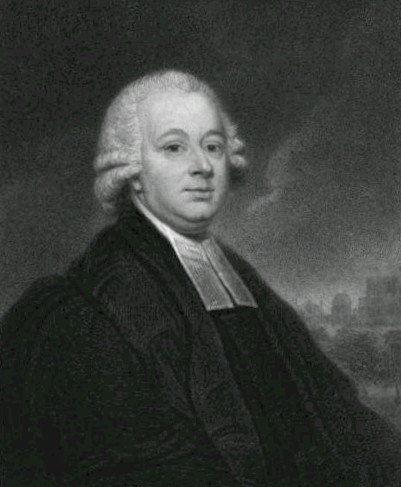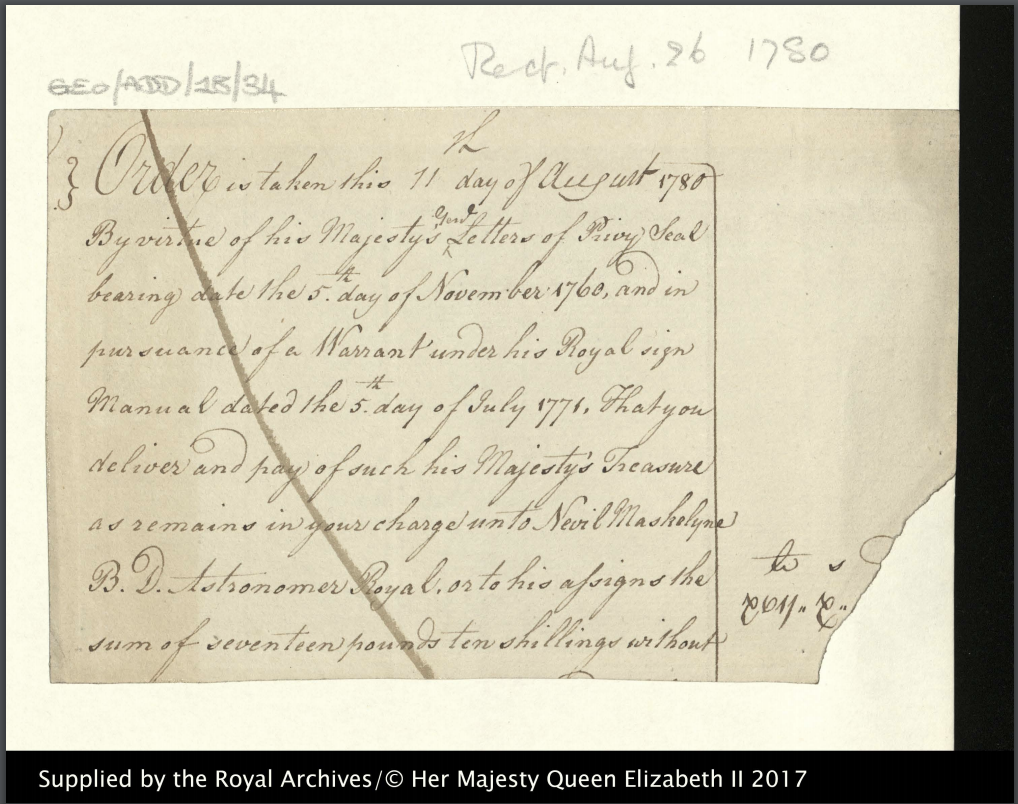Summer Stargazing: Nevil Maskelyne, Astronomer Royal
By Marie Pellissier, Omohundro Institute Apprentice, William & Mary
Welcome back to our Georgian Goodies blog series, where we highlight interesting, timely, or just plain nifty documents from the Georgian Papers Programme!
The middle of August is an astronomically interesting time. The Perseid meteor showers are at their peak in the Northern Hemisphere, and the Delta Aquariid shower is still visible too.[1] Astronomy may simply be interesting to us, but in the eighteenth century, it was an essential part of the Royal Household. On August 11, 1780, an order was issued to pay Nevil Maskilyne, B.D. (Bachelor of Divinity) seventeen pounds and ten shillings, in accordance with his appointment as the Astronomer Royal.[2] Why on earth did the royal family need an astronomer? The answer lies not on earth, but on the sea–and in the skies.
The position of Astronomer Royal was established as part of the Royal Household in 1675, when Charles II granted an annual salary of 100 pounds to John Flamsteed, a self-taught astronomer. Flamsteed was to aid the monarch in understanding the principles of celestial navigation, and record and publish exact data related to the motion of the stars.[3] In the seventeenth century, mariners relied almost entirely on the night sky for navigation, and exact data was essential to accurate navigation.
Soon after he appointed John Flamsteed as the first Royal Astronomer, Charles II established a small observatory at Greenwich–which continues today as the Royal Greenwich Observatory. Indeed, the first building on those grounds was Flamsteed House, which served as a home for John Flamsteed and his family and servants, as well as an observatory, for most of his forty-year tenure as Astronomer Royal.[4] Flamsteed made significant contributions to mapping the stars but was hesitant to publish his own work. Isaac Newton, frustrated by Flamsteed’s reticence, published Flamsteed’s work without his permission, souring relations between the two scientists.[5]
The second Astronomer Royal is perhaps most well known for the comet that bears his name. Edmond Halley was appointed to the post in 1720. 64 years old, he had already calculated and published the periodicity of what we now call Halley’s Comet. As Astronomer Royal, Halley had to replace the equipment at the Royal Observatory (upon Flamsteed’s death, his widow had taken all of the observational equipment as her husband’s personal property). After Halley’s death in 1742, the post was held by James Bradley (1742-1762) and Nathaniel Bliss (1762-1764).

Portrait of Nevil Maskelyne by Edward Scriven
Nevil Maskelyne was born in London in 1732, and attended Westminster School as a child. At the age of seventeen he went to Cambridge for his university studies, and graduated from Trinity College with a BA in 1754 and a MA in 1757. Ordained in 1755, he was a clergyman as well as a mathematician. After the solar eclipse of 1748, he became deeply interested in astronomy, and in the 1750s, he began working with James Bradley, the Astronomer Royal.[6] With Bradley’s support, Maskelyne became a Fellow of the Royal Society in 1758. His correspondence with Bradley led to his involvement in the era’s biggest astronomical question: the calculation of accurate longitude.
In an era before GPS and satellites, ship captains relied on the stars to calculate their position and navigate. It was relatively easy to calculate latitude (one’s position north or south) by calculating the angle of the stars. Calculating longitude was far more difficult, but particularly important for transoceanic mariners. Indeed, finding a way to calculate longitude accurately was so important that in 1714, Parliament passed the Longitude Act, which offered a series of rewards to those who could calculate longitude with the most accuracy.[7]
Tobias Mayer, a Hanoverian astronomer, used data from James Bradley to assemble more accurate tables of the Moon’s motion than previous astronomers had been able to calculate. Bradley, meanwhile, commissioned a brass “repeating circle” to calculate lunar distance, or the distance between the Moon and a star–either the Sun or some other star (this distance is often referred to as simply “lunars”). This “repeating circle” became the first maritime sextant, and it was Nevil Maskelyne who proved that it worked.
On a trip to St. Helena in 1761, Maskelyne observed the transit of Venus across the face of the Sun for the Royal Society. He also used his time at sea to experiment with Mayer’s lunar tables and Bradley’s sextant. At the end of the voyage, Maskelyne was able to prove that using lunars decreased errors in longitude by 85%, making this method vastly more effective and accurate than dead reckoning, which was essentially a rough estimate based on the ship’s known position, speed, and direction.[8]

The Nautical Almanac and Astronomical Ephemeris for the year 1767. Courtesy of the National Maritime Museum, NAO1767.
In 1765, Maskelyne was appointed Astronomer Royal. An advocate of the lunar method for calculating longitude, he decided to produce an almanac of the movements of the moon, as well as other observations that were useful to navigation. Using poorly paid mathematical assistants to do much of the grunt work, the first Nautical Almanac and Astronomical Ephemeris, containing data for 1767, was published at the end of 1766.[9]
Maskelyne was also the lead scientist of the 1774 Schiehallion Experiment, which attempted to calculate the density of the earth. Isaac Newton had postulated that if a pendulum hung straight down, and a much larger mass like a mountain was nearby, then the mountain’s gravity would pull the pendulum out of line. If one knew the volume and mass of the pendulum and could measure how far out of line it was, one could calculate the mass of the larger object (in this case, the mountain). The Schiehallion Experiment tried to do just that, and Maskelyne and his team estimated the Earth’s density to be 4.5 x 1024 kilograms. The Earth’s mass as calculated today is 5.89 x 1024 kilograms, meaning that Maskelyne and his team were about 80 percent accurate. That’s pretty impressive in an age before computers![10]
The position of Astronomer Royal continues today, though the position is largely honorary. The current Astronomer Royal, Martin Rees, Baron Rees of Ludlow, was appointed in 1995, and is a leading astrophysicist who has worked on black hole formation and extragalactic radio waves.[11] But Nevil Maskelyne’s position as Royal Astronomer, which he held until his death in 1811, was no symbolic post. He played an essential role in simplifying navigational calculations in the age of British imperial expansion. While it’s unclear from the fragment included in the Georgian Papers exactly what the Royal Household was paying him for in 1780, we know that his position was essential to expanding British interests, as well as contributing to the expansion of scientific understanding of the world.
[1]Bruce McClure and Deborah Byrd, “Delta Aquariids 2019: All You Need to Know,” EarthSky, July 23, 2019. Accessed August 11, 2019. https://earthsky.org/astronomy-essentials/everything-you-need-to-know-delta-aquarid-meteor-shower.
[3] The Royal Household, “Astronomer Royal,” Archive.org, 2016, accessed August 11, 2019. https://web.archive.org/web/20160308012357/http://www.royal.gov.uk/TheRoyalHousehold/OfficialRoyalposts/AstronomerRoyal.aspx
[4] Royal Museums Greenwich, “History of the Royal Observatory,” n.d., accessed August 11, 2019. https://www.rmg.co.uk/royal-observatory/history
[5] Royal Museums Greenwich, “The Astronomer Royal,” n.d., accessed August 12, 2019. https://www.rmg.co.uk/discover/explore/astronomer-royal
[6] Royal Greenwich Observatory Archives, “Papers of Nevil Maskelyne (finding aid)”, n.d. Accessed 8/12/2019. https://janus.lib.cam.ac.uk/db/node.xsp?id=EAD%2FGBR%2F0180%2FRGO%204.
[7]Royal Museums Greenwich, “Longitude Found: Nevil Maskelyne and the Lunar Method,” n.d., accessed August 15, 2019. https://www.rmg.co.uk/discover/explore/longitude-found-nevil-maskelyne-and-lunar-method; Rebekah Higgitt, “Nevil Maskelyne,” Cambridge Digital Libraries, 2015, accessed August 14, 2019.
[8]“Longitude Found”; Katy Barrett, “Journal of Voyage to St Helena (RGO 4/150),” University of Cambridge Digital Library, n.d., accessed August 14, 2019. http://cudl.lib.cam.ac.uk/view/MS-RGO-00004-00150/1.
[9]“Longitude Found”
[10] Schiehallion Partners, “The Schiehallion Experiment,” n.d., accessed August 16, 2019. http://www.schiehallionpartners.com/the-schiehallion-experiment/; “The Mountain That Made Scientific History,” The Scotsman, February 1, 2006. Accessed August 16, 2019. https://www.scotsman.com/lifestyle-2-15039/the-mountain-that-made-scientific-history-1-466221; “Papers of Nevil Maskelyne (finding aid).”
[11]The Royal Society, “Martin Rees,” in the Fellows Directory, 2019. Accessed 8/17/2019. https://royalsociety.org/people/martin-rees-12156/

